In May, I completed a King’s study-abroad course in Berlin, Germany called “Memory, Politics, Place: Berlin’s Twentieth Century.”
Twenty-four of my peers in the King’s Contemporary Studies Program, two of our amazing professors (Sarah Clift and Maria Euchner) and our residence assistants travelled to Berlin to take part in the course, from May 3 to 26. Together, we investigated the dynamics of memory in Germany—how the catastrophes of the country’s twentieth century are understood and remembered. We discussed memory at the individual and collective level, and how memory materializes in the cityscape in the form of monuments and museums.
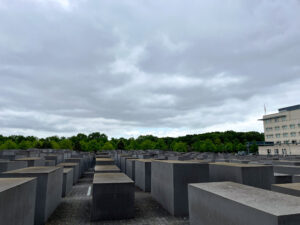
Our class took a tour of monuments developed in memory of the victims of the Holocaust. This is the Memorial to the Murdered Jews of Europe.
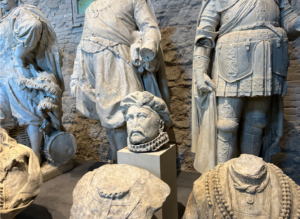
We went to visit the Zitadelle (citadel) in Spandau. The Zitadelle houses an exhibit called “Unveiled” which displays statues that have been taken down and removed from fallen spaces. We were able to touch these “fallen” statues which was extremely cool.
After covering these topics through readings and lectures, we visited relevant monuments and places of commemoration. For example, we read Karen Till’s 2005 essay “Aestheticizing the Rupture,” written in the aftermath of debates and design competitions for the development of a Holocaust memorial. We discussed Till’s essay and the wider context of Berlin’s Holocaust memorial in lecture, and then visited and toured the memorial, known as the Memorial to the Murdered Jews of Europe. The balance between a theoretical and experiential approach enriched my understanding of the topics we discussed and my experience in the city of Berlin itself.
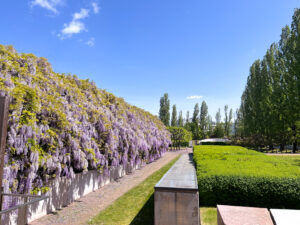
This is an arbor outside the Jewish Museum leading from the Old Building to the garden.

We took a tour of the museum which discussed the architecture of the space and its exhibits on the Holocaust. We also walked through exhibits on Jewish life in Germany before and after the war.
On weekends, we were able to explore nearby towns and cities, venturing out on our own. A friend and I visited the Spreewald forest region, which was a one-hour train ride away from Berlin. We rented bikes to ride by the river and wandered around the small town of Lübbenau.

On the weekend, I went on a day trip to Spreewald, a UNESCO Biosphere Reserve. We explored the area by bike and were happy to discover that the small town where we got lunch was also the pickle capital of Germany.
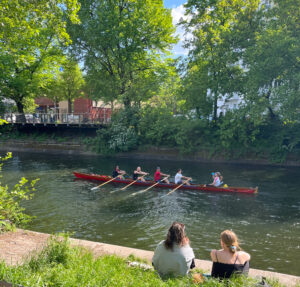
I took this picture while sitting by the Spree River in Kreuzberg doing some course readings. People were sitting all along the river and also boating through it!
Spending almost a month in Berlin allowed us the freedom to explore other areas and to gain familiarity and comfort in the city—to find and return to favourite coffee spots and ice-cream shops and learn some German phrases. It was a transformative experience to arrive in Berlin feeling disoriented and to leave feeling comfortable and at-home. This time also allowed for spontaneity and unexpected experiences. One Saturday, our hostel happened to be selling tickets to the Hertha vs. Stuttgart football (soccer!) game. With nothing else planned for the day, we decided to buy tickets. We ate pretzels and bratwurst, cheered on Berlin’s team, and experienced the lively atmosphere of a German football match—an experience that we likely would not have had otherwise. The game took place in the Olympiastadion, the stadium developed by Hitler and Nazi architects for the 1936 Olympic Games.
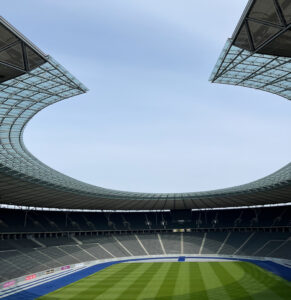
During one of our lectures, our class discussed the relationship between fascism and architecture. Then, we went on a tour of the Olympiastadion, the stadium developed by Hitler for the 1936 Olympic Games.
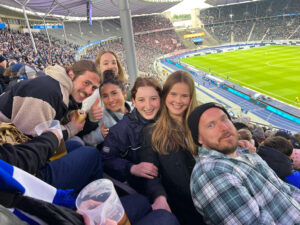
The stadium has been updated and remodeled and remains in use today. This is a photo of a group from our hostel on an outing to the soccer game — Berlin vs. Stuttgart. The stadium looked completely different packed with cheering fans. Berlin won and the crowd went wild!
We had toured the stadium with our class two days prior for our lesson on fascism and architecture, and revisiting for the game added an entirely new layer of meaning to what we had discussed. The city is filled with remnants and material reminders of its history, and this is one of countless examples of our experience in Berlin being informed by our exploration of its past.
The balance between a theoretical and experiential approach enriched my understanding of the topics we discussed and my experience in the city of Berlin itself.
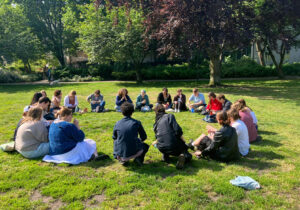
We did our final class in the park this morning. We are so sad that our time is coming to an end!
I chose to study Contemporary Studies at King’s because of the small classes filled with excited and hardworking students and passionate professors. This course in particular encompassed the collaborative and animated learning style that originally drew me to King’s, with the invaluable bonus of being in the very place described in its readings and lectures.
I first learned about this course opportunity through an Instagram post I saw a few years ago when I was applying to study at King’s. It’s hard to believe that I am now the person sharing their experience in Berlin with the King’s community. The course both lived up to and surpassed my expectations—I had not anticipated how much the educational experience and the fun of living abroad would enhance each other. When reflecting on my time to date at King’s, “Memory, Politics, Place: Berlin’s Twentieth Century” stands out as an academic and personal highlight.
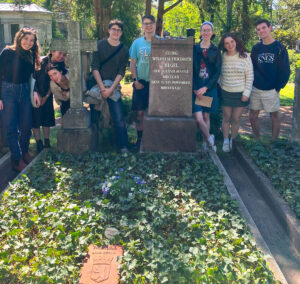
Second-year Contemporary Studies students beside the grave of Hegel, one of the main theorists we read this year.

